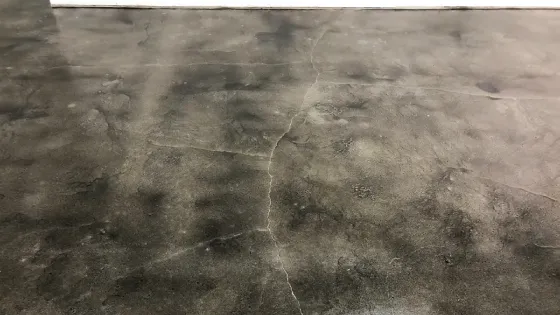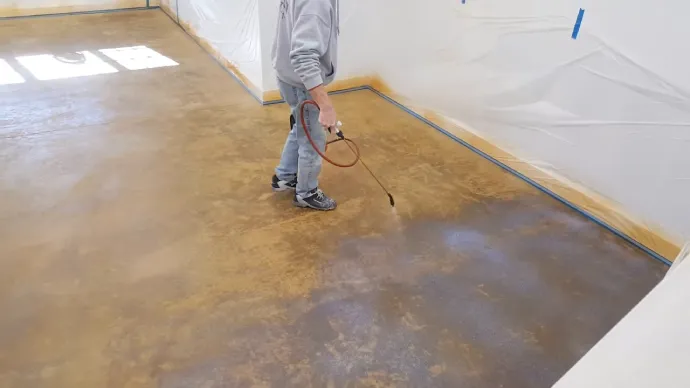If you have recently installed stained concrete in your home or plan to do so, you may wonder if you need to seal it. According to experts, you should permanently seal stained concrete.
Not only does it enhance the appearance of the concrete, but it also protects it from damage and helps it to last longer. It also helps to prevent moisture from penetrating the surface, which can cause the concrete to crack and peel over time.
And it protects the concrete from extrinsic stains and damage caused by spills, chemicals, and foot traffic.
Here, we will discuss step-by-step instructions on properly sealing your stained concrete and answer some common questions about maintaining and cleaning it.
Steps on How Do You Seal Stained Concrete

The sealing of stained concrete enhances its appearance, protects it from damage, and extends its life. Here is a step-by-step guide on how to seal stained concrete:
- Step 01: Prepare the surface
- Step 02: Choose the appropriate sealer
- Step 03: Apply the sealer
- Step 04: Apply matte wax (Optional)
Step 01: Prepare the Surface
Clean your surface thoroughly and remove all particles or debris that may interfere with the adhesion of the sealant to ensure a successful seal. This is an important step that shouldn’t be overlooked. Studies show that a dirty surface can reduce the effectiveness of the sealant by up to 50%.
To clean the surface, use a quality degreasing cleaner and a stiff brush to scrub it thoroughly. Rinse off the dirt and residue with clean water and allow the surface to dry completely before applying sealant.
Step 02: Choose the Appropriate Sealer
For the best results, you should select the right sealer based on the specific needs of your project and the desired outcome you’re looking for. Various types of sealers are available, each with its advantages and disadvantages.
Here are some tips to help you choose the appropriate sealer for your stained concrete:
i) Consider the type of stained concrete you have. For instance, if you have acid-stained concrete, then a penetrating sealer would be a suitable choice. On the other hand, if you have water-based stained concrete, then an acrylic-based sealer would be more appropriate.
ii) Think about the level of gloss you want. A polyurethane-based sealer will be ideal if you want a high-gloss finish. But a penetrating sealer is better if you prefer a more natural look.
iii) Determine the expected amount of foot traffic. If the stained concrete surface is exposed to heavy foot traffic, then a polyurethane-based or epoxy sealer would be the best option. These sealers are more durable and can withstand wear and tear better than other types of sealers.
Keep in mind that proper sealer application tools are necessary for precise work. Our reviews of the best concrete sealer sprayer will help you find out which products are top-rated. Plus, they’ll help you easily apply the sealer of your choice to your stained concrete.
Step 03: Apply the Sealer
Follow the manufacturer’s instructions on the sealer product for the application. Typically, the process involves the following steps:
a. Test the Sealer
You’ll want to ensure the sealer works with your stained concrete, so try it out on a small, hidden spot first. Observe any changes in the concrete’s color or texture and ensure the sealer is not causing any discoloration or unwanted effects.
Once you’re satisfied with the results, proceed with applying the sealer on the rest of the stained concrete.
b. Start From a Corner
Begin by applying the sealer from a corner or edge when sealing your stained concrete surface. This will ensure that you don’t accidentally step on the freshly sealed areas and ruin your hard work.
c. Use a Roller or Sprayer
To get the best results from your sealer, equally, apply it using a roller or sprayer. When using a roller, make sure to use even pressure and avoid leaving lap marks. If you’re using a sprayer, always keep the nozzle moving to prevent pooling and ensure even coverage.
d. Apply Multiple Coats
Depending on the sealer type and desired level of protection, it may be necessary to apply multiple coats for a lasting and high-quality finish.
When applying multiple coats, following the manufacturer’s instructions regarding the recommended number of coats and drying time between each application is crucial.
Typically, two to three coats are recommended for optimal protection. Ensure that each coat is applied evenly and allowed to dry completely before applying the next coat.
Multiple coats will not only enhance the durability and longevity of the sealer but also give the stained concrete surface a more consistent and uniform appearance.
e. Allow Drying Time
Make sure to give the sealer enough time to dry completely before walking or doing any other activities on the treated surface.
Remember that drying times can vary depending on the sealer type and environmental conditions. To ensure that the sealer is fully dry, refer to the product instructions for specific drying times.
Rushing the drying process can result in damage to the sealer, which can compromise the protection it provides to the stained concrete. Therefore, it’s wise to be patient and allow the sealer to dry completely before subjecting the stained concrete to foot traffic or other activities.
Step 04: Apply Matte Wax (Optional)
For a more subtle finish, add a matte wax layer on top of the sealer. This will give your stained concrete a muted tone that is suitable for some applications. To achieve this look, follow these steps:
- Make sure the sealer is completely dry before applying the wax.
- Apply the wax according to the manufacturer’s instructions using a clean cloth or applicator. Be sure to cover the entire surface evenly.
- Allow the wax to dry completely before buffing it to achieve the desired level of sheen. You can use a buffing machine or simply a clean cloth to achieve this.
Notes: Sealing stained concrete is not a one-time process. Over time, the sealer may wear off due to heavy traffic or exposure to the elements. Regular cleaning and reapplication of the sealer may be necessary to maintain the protection and appearance of the concrete.
Can you stain concrete and not seal it?

If you’re planning on acid-staining your concrete surface, you should also seal it afterward. This will help maintain the vibrancy of the color and protect it from damage caused by foot traffic, UV rays, and spills.
Leaving the concrete unsealed can result in the color fading over time as well as making the surface more porous and susceptible to stains, cracking, and dust accumulation. It can also make the surface harder to clean and maintain.
Is stained concrete hard to maintain?
Maintaining the beauty of your stained concrete requires a little effort, but it’s worth it. But sealing your concrete makes it easier to clean and maintain. Here are three tips for maintaining your stained concrete:
i) Sweep and mop regularly: Dirt and debris can scratch the surface of your concrete, so mop and sweep it regularly to keep it clean. Mopping with a damp mop is also a good idea to remove any dirt that has been ground into the surface.
ii) Use a pH-neutral cleaner: Avoid using harsh chemicals or acidic cleaners on your stained concrete. Instead, use a pH-neutral cleaner to help preserve the stain and the sealer.
iii) Reapply the sealer: Over time, the sealer on your concrete can wear away, leaving the surface vulnerable to damage. You should reapply the sealer every few years to help protect your stained concrete and keep it looking great.
Can you pressure wash stained concrete?
If you want to keep your stained concrete looking fresh and clean, pressure washing is also a recommended way to maintain it. This method effectively removes dirt, grime, and loose sealant from your concrete surface. But keep in mind that not all stained concrete is the same.
Sealed concrete is safe to be pressure washed, while unsealed concrete is more porous and requires more caution. In such cases, a lower-pressure setting or a hose would be a better fit. Understanding your concrete type is crucial for proper care and cleaning.
Protect and Enhance Your Stained Concrete with Proper Sealing
The benefits of sealing stained concrete cannot be overemphasized. It enhances the appearance of the concrete and offers protection against damage, extends the surface’s lifespan, and prevents moisture penetration that can lead to cracks and peeling.
It is worth noting that sealing provides a safeguard against spills, chemicals, and foot traffic-related damage.
To ensure a durable and visually appealing finish for your stained concrete, proper surface preparation, selecting the appropriate sealer, applying it correctly, and considering optional matte wax are crucial steps to follow.
Regular maintenance is essential to keep the stained concrete looking its best. By following these guidelines from experts in the field, you can enjoy the beauty and longevity of your stained concrete surface for decades.
